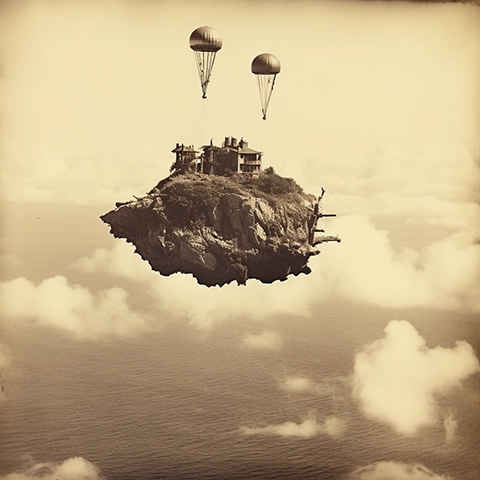In 1889, amidst the bustling fervor of the Industrial Revolution and the growing scarcity of affordable land, an audacious inventor named Reginald Archibald took it upon himself to challenge the very fabric of conventional living. Spurred by the escalating costs of property and a visionary dream to establish his dominion, Archibald embarked on a bold experiment to create a floating island, high above the ocean, sustained by the buoyancy of helium balloons.
To materialize his grand vision, Archibald chose a small mound of earth as the foundation for his aerial utopia. Atop this modest plateau, he constructed an expansive and lavishly adorned house, sparing no expense or attention to detail. The structure was an architectural marvel, complete with all the amenities and comforts of a ground-based abode. The floating island was a testament to Archibald’s ingenuity and determination.
In a bid to defy gravity, Archibald ingeniously employed the use of helium balloons to elevate his island into the sky. Helium, a gas lighter than air, provided the necessary lift to hoist the island and its grand residence above the ocean’s expanse. For a brief, glorious week, Archibald’s floating island soared through the skies, capturing the imagination of a nation and the attention of the world.
Despite the initial success and the awe it inspired, the practical challenges of living suspended above the ocean soon became apparent. Archibald had not thoroughly contemplated the logistics of resupplying his floating sanctuary. The isolation of the airborne abode made it exceedingly difficult to acquire essential provisions, and the task of ascending and descending from the floating island proved to be a formidable hurdle.
As the days passed, the limitations of Archibald’s venture became increasingly evident. The cost of maintaining the helium balloons and ensuring the structural integrity of the floating island proved to be astronomical. Moreover, the isolation and impracticality of the endeavor weighed heavily on Archibald’s spirits.
Faced with the harsh realities of his lofty experiment, Archibald was compelled to concede that his vision of establishing an independent nation state in the skies was, in fact, an impractical fantasy. The floating island, once a symbol of innovation and audacity, was brought back down to earth, marking the end of Archibald’s aerial adventure.
In the years that followed, the tale of Archibald’s floating island became a fascinating chapter in the annals of history, serving as a poignant reminder of the boundless reaches of human imagination and the sobering constraints of practicality. The story would later serve as a whimsical inspiration for the 2009 animated film “Up,” in which an elderly man named Carl Fredricksen uses helium balloons to lift his house off its foundation, embarking on a fantastical adventure through the skies. Though the narrative of “Up” diverges significantly from Archibald’s real-life endeavors, the essence of daring to dream and the desire to escape the binds of conventional living resonate deeply with the tale of the floating island. Archibald’s story, and the lessons it imparts, continue to capture the imagination of generations, reminding us all of the power of innovation and the enduring allure of the skies.

